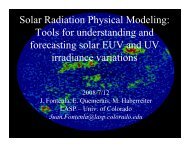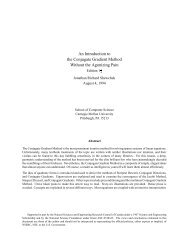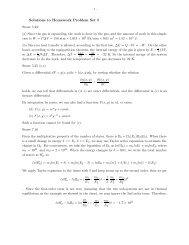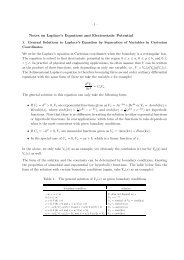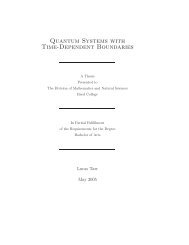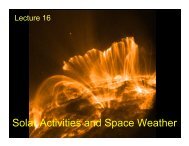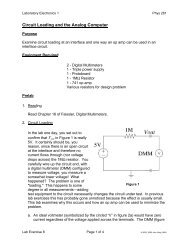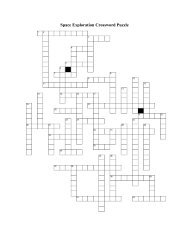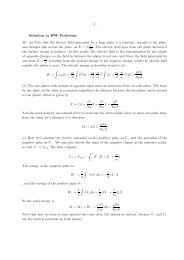Magara, T., Shibata, K., & Yokoyama, T. 1997, ApJ, 487, 437
Magara, T., Shibata, K., & Yokoyama, T. 1997, ApJ, 487, 437
Magara, T., Shibata, K., & Yokoyama, T. 1997, ApJ, 487, 437
You also want an ePaper? Increase the reach of your titles
YUMPU automatically turns print PDFs into web optimized ePapers that Google loves.
442 MAGARA, SHIBATA, & YOKOYAMA Vol. <strong>487</strong><br />
netic island, and the other is the coalescence process of the<br />
multiple magnetic islands.<br />
Figures 5a and 5b indicate the variations of the upward<br />
velocity of the magnetic island with r and g , respectively.<br />
Here the upward velocities are derived from init<br />
the inclinations<br />
obtained by those line Ðttings in all models (models r1Èr4,<br />
g1Èg3) similar to Figure 3. In both Ðgures asterisks and<br />
crosses represent the upward velocities at the Ðrst stage<br />
(before the acceleration) and the third stage (after the<br />
acceleration), respectively. Thick curves are the results of<br />
such curve Ðttings as v \ arb and cgd , where a, b, c,<br />
and d are all constant. upward<br />
When r \ 0 or g init<br />
\ 0, we obtain<br />
v \ 0, which means there is no initial init<br />
perturbation.<br />
upward<br />
These Ðgures tell us that the upward velocities at both the<br />
Ðrst and the third stages decrease as the initial perturbation<br />
becomes weak (in a sense of r and g ] 0). Moreover, there<br />
is a di†erence in a manner of decrease init<br />
between both stages.<br />
Looking at the powers in the results of the curve Ðttings, the<br />
decrease at the third stage is gentler than at the Ðrst stage.<br />
This di†erence can be considered to reÑect the each stageÏs<br />
sensitivity to the initial perturbation; the upward velocity at<br />
the Ðrst stage is directly connected with the initial perturbation,<br />
while the upward velocity at the third stage is under<br />
the circumstance in which the anomalous resistivity already<br />
arises so that the e†ect of the initial perturbation on this<br />
stage is relatively weak.<br />
Figure 6a (Plate 6) shows the evolution of model M. Top<br />
and bottom panels are the temperature and density maps,<br />
respectively. Contours represent the magnetic Ðeld lines<br />
projected onto the (x, z) planes, and arrows represent the<br />
Ñuid velocity Ðelds on the same planes. At t \ 5.0 we can<br />
Ðnd four X-points (z \ 5, 10, 15, and 20), which correspond<br />
to the initially perturbed positions. Figure 6b shows this<br />
modelÏs temporal variations of both the height of every four<br />
magnetic island and the neutral-point electric Ðeld at the<br />
lowest X-point (z \ 5) which always has a higher value than<br />
any other X-points (z \ 10, 15, and 20). Crosses, asterisks,<br />
dots, and diamonds represent the height of every magnetic<br />
island, while the thin solid line shows the temporal variation<br />
of the neutral-point electric Ðeld at the lowest X-point.<br />
The temporal variation of the height of the lowest magnetic<br />
island is line-Ðtted in the same way as in Figure 3, and the<br />
results are represented by two thick solid lines.<br />
From Figure 6a, it can be seen that the lowest magnetic<br />
island continues to merge the other upper islands except the<br />
highest one with time. At t \ 20, there appears a welldeveloped<br />
magnetic island between z \ 10 and z \ 20, at<br />
the bottom of which a hot and dense region is formed. This<br />
conÐguration is quite similar to the one at t \ 12 in Figure<br />
2b and 2c. Referring to Figure 6b, we can Ðnd that the<br />
coalescence process occurs, and there are some similar features<br />
to what are recognized in the single perturbed region<br />
models described above, such as the existence of three<br />
stages in the dynamical evolution of the magnetic island<br />
and the time lag between the start time of the magnetic<br />
island acceleration and the peak time of the neutral-point<br />
electric Ðeld.<br />
On the basis of those results shown above, we consider<br />
that those two featuresÈthe existence of three stages in the<br />
dynamical evolution of the magnetic island and the time lag<br />
between the start time of the magnetic island acceleration<br />
and the peak time of the neutral-point electric ÐeldÈare<br />
important factors in understanding the evolution of plasmoid<br />
eruptions. In ° 5, we discuss them in detail, but before<br />
FIG. 5.ÈVariations of upward velocity of magnetic island with (a) r<br />
(models r1Èr4) and (b) g (models g1È3 and r3), respectively. Upward<br />
velocities are derived from init<br />
the inclinations obtained by line Ðttings for<br />
temporal variations of height of magnetic island in each model similar to<br />
Fig. 3. In both Ðgures asterisks and crosses represent upward velocities at<br />
the Ðrst stage (before acceleration) and the third stage (after acceleration),<br />
respectively. Thick curves are the results of such curve Ðttings as v \<br />
arb and cgd , where a, b, c, and d are all constant.<br />
upward<br />
init<br />
FIG. 6b



